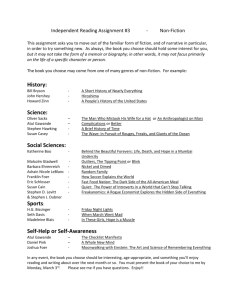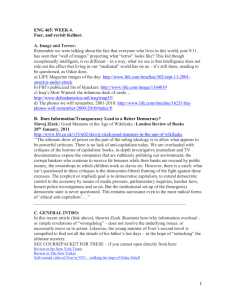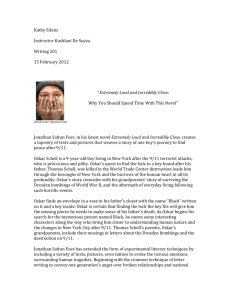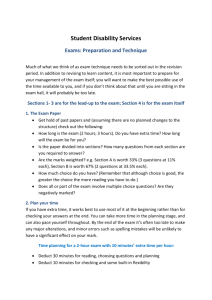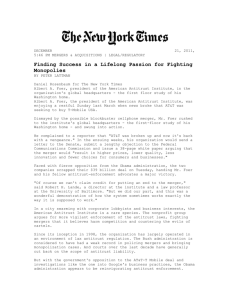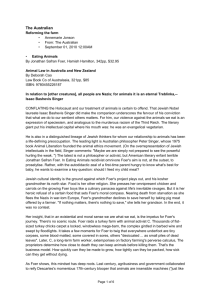AP® Calculus Syllabus and Course Outline
advertisement
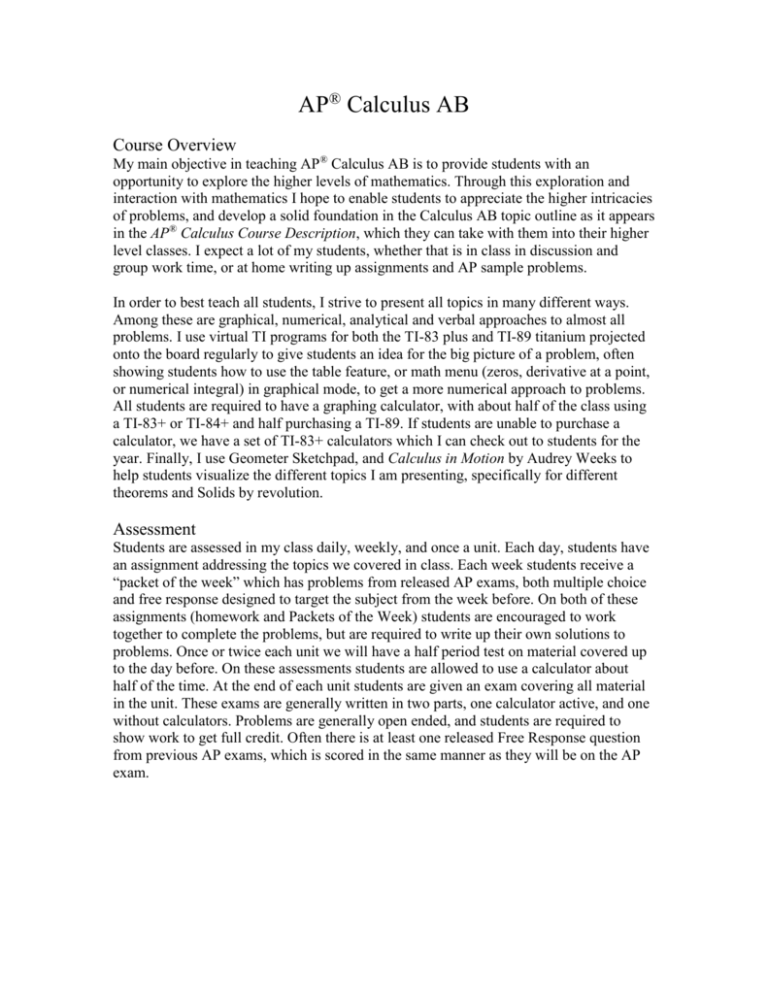
AP® Calculus AB Course Overview My main objective in teaching AP® Calculus AB is to provide students with an opportunity to explore the higher levels of mathematics. Through this exploration and interaction with mathematics I hope to enable students to appreciate the higher intricacies of problems, and develop a solid foundation in the Calculus AB topic outline as it appears in the AP® Calculus Course Description, which they can take with them into their higher level classes. I expect a lot of my students, whether that is in class in discussion and group work time, or at home writing up assignments and AP sample problems. In order to best teach all students, I strive to present all topics in many different ways. Among these are graphical, numerical, analytical and verbal approaches to almost all problems. I use virtual TI programs for both the TI-83 plus and TI-89 titanium projected onto the board regularly to give students an idea for the big picture of a problem, often showing students how to use the table feature, or math menu (zeros, derivative at a point, or numerical integral) in graphical mode, to get a more numerical approach to problems. All students are required to have a graphing calculator, with about half of the class using a TI-83+ or TI-84+ and half purchasing a TI-89. If students are unable to purchase a calculator, we have a set of TI-83+ calculators which I can check out to students for the year. Finally, I use Geometer Sketchpad, and Calculus in Motion by Audrey Weeks to help students visualize the different topics I am presenting, specifically for different theorems and Solids by revolution. Assessment Students are assessed in my class daily, weekly, and once a unit. Each day, students have an assignment addressing the topics we covered in class. Each week students receive a “packet of the week” which has problems from released AP exams, both multiple choice and free response designed to target the subject from the week before. On both of these assignments (homework and Packets of the Week) students are encouraged to work together to complete the problems, but are required to write up their own solutions to problems. Once or twice each unit we will have a half period test on material covered up to the day before. On these assessments students are allowed to use a calculator about half of the time. At the end of each unit students are given an exam covering all material in the unit. These exams are generally written in two parts, one calculator active, and one without calculators. Problems are generally open ended, and students are required to show work to get full credit. Often there is at least one released Free Response question from previous AP exams, which is scored in the same manner as they will be on the AP exam. Textbooks We use two textbooks primarily; each student has a copy of both textbooks: Larson, Roland E., Hostetler, Robert P., and Edwards, Bruce H. Calculus with Analytic Geometry. 4th edition. Lexington, Mass: DC Heath and Company. 1990. Foerster, Paul A., Calculus Concepts and Applications. 1st edition. Emeryville, CA: Key Curriculum Press. 1998. Supplemental material: Kamischke, Ellen. A Watched Cup Never Cools. Emeryville, CA: Key Curriculum Press. 1999. Ostebee, Arnold. Zorn, Paul. Calculus from Graphical, Numerical and Symbolic Points of View – Volume 1. 1st edition. Fort Worth: Saunders College Publishing – Harcourt Brace College Publishers. 1997. Course Outline: All timelines are approximate and include review and testing times. These will be adjusted according to student comprehension. Foer stands for our Foerster book, and LHE stands for our Larson, Hostetler, Edwards book. Unit 1 – Limits (13 days) Foer 1-1 – average vs. instantaneous rate – estimating limits LHE 2.1 – tangent line problem/intro to limits – table, graph and algebra LHE 2.2 – properties of limits LHE 2.3 – techniques for evaluating limits LHE 2.4 – continuity and intermediate value theorem Foer 2-4 – continuity of piecewise functions LHE 2.5 – infinite limits and vertical asymptotes LHE 4.5 – limits at infinity and horizontal asymptotes Unit 2 – Concept of the Derivative (14 days) Foer 1-2 – rate of change by equation, graph, and table Foer 3-1 – graphical interpretation of derivative Foer 3-2 – difference quotient, derivative at c Foer 3-4 – derivative at x, properties of derivatives Foer 3-5 – displacement, velocity and acceleration Foer 3-6 – intro to sine, cosine, composite functions Foer 3-7 – chain rule Foer 3-8 – writing sinusoidal equations Unit 3 – Derivative Formulas (15 days) Foer 4-2 – product rule Foer 4-3 – quotient rule Foer 4-4 – trigonometric functions Foer 4-5 – inverse functions, inverse trigonometric functions Foer 4-6 – differectiability and continuity, piecewise function Foer 4-8 – implicit differentiation LHE 3.7 – related rates Foer 10-4 – related rates Unit 4 – Graphical Analysis (23 days) LHE 4.1 – extrema, extreme value theorem LHE 4.2 – Rolle’s Theorem, Mean Value Theorem Other sources (Ostebee and Zorn) – plotting derivatives, geometry of derivatives, geometry of second derivatives LHE 4.3 – increasing/decreasing, first derivative test LHE 4.4 – concavity, point of inflection, second derivative test LHE 4.6 – curve sketching LHE 4.7 – optimization Foer 10-5 – minimal paths Unit 5 – Integrals (21 days) Foer 1-3 – intro to definite integrals Foer 5-1 – intro to definite integrals Foer 3-9 – antiderivatives and indefinite integrals Foer 5-2 – review of antiderivatives Foer 5-3 – linear approximations and differentials Foer 5-4 – antiderivatives and indefinite integrals, u-substitution Foer 1-4 – trapezoid rule (including unequal intervals from outside source) Foer 5-5 – Riemann sums and definite integrals Foer 5-6 – Mean Value Theorem and Rolle’s Theorem Foer 5-7 – special Riemann sums Foer 5-8 – Fundamental Theorem of Calculus Foer 5-9 – properties of definite integrals Other sources – Functions defined by integrals/FTC 2/Area Function Unit 6 – Exponential and Logarithmic Equations (17 days) LHE 6.1 – natural logarithmic function and definition of e LHE 6.1 – derivative of natural logarithm, logarithmic differentiation LHE 6.2 – antiderivatives of reciprocal function and trigonometric functions LHE 6.3 – inverse functions LHE 6.4 – derivative of natural exponential function, antiderivatives of LHE 6.5 – exponential functions with other bases Unit 7 – Applications of Integrals (15 days) LHE 7.1 – area between two curves LHE 7.2 – volume by discs, washers and known cross-sections Foer 10-2 – distance vs. displacement, speed vs. velocity Foer 10-3 – average value Unit 8 – Differential Equations (11 days) Differential Equations and Slope Fields will be covered using materials from other books in my collection. Both are not covered particularly well in either of our textbooks. Topics covered: Solutions (general and specific) to separable differential equations Slope Fields Exponential Growth and Decay – specifically as it relates to modeling Unit 9 – AP Exam Review (22 days) Students are the major drivers in review. We spend one or two days on each of the previous units, with some sample questions given to students each day. For homework, students write 5 questions on notecards, with full solutions on the back. From these questions, we review as a class each topic. We play a “chess” game where pieces move according to specific functions across the board, and to take a person’s piece you must answer a question correctly. This encourages students to dialog together, as they discuss why an answer is correct, including defending their position if their answer is different from the stated answer. Post AP exam: After the exam, I give students a number of projects. Specifically, students design review games for my students next year, create solids of revolution to help explain this topic to the next year class (very helpful for those students who do not visualize this well!), as well as research a famous mathematician and teach the class about the mathematician’s research.
